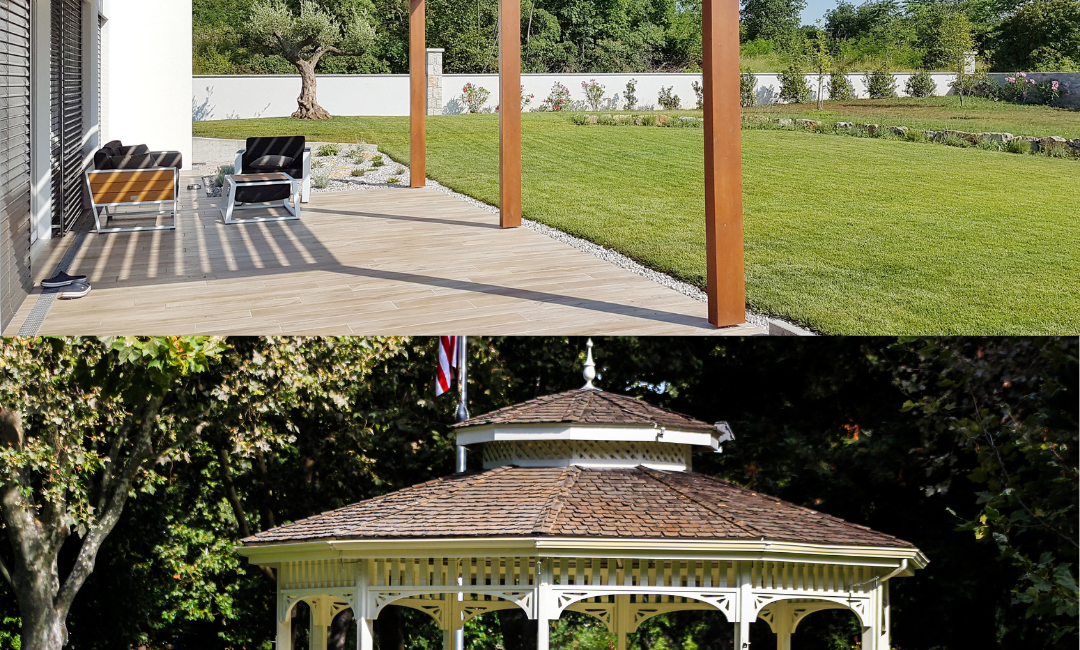Choosing the right feature for one’s backyard makeover is a significant decision for many homeowners. Pergolas and gazebos are two standout choices, each capable of transforming any outdoor space. These backyard structures enhance the visual appeal and add practical value to the property — which is why choosing one is tough.
This article compares of pergolas and gazebos to help readers navigate through their differences and benefits. With this guide, homeowners can decide which structure will make their backyard space functional and inviting, ensuring their outdoor living space becomes the envy of the neighborhood.
Key Differences Between Pergolas and Gazebos
Roof Structure
The roof designs of pergolas and gazebos differ significantly, influencing not only their appearance but also their functionality.
Pergolas feature a slatted roof, typically made of horizontal beams spaced apart to allow natural light to filter through. This design provides partial shade, making pergolas ideal for those who prefer a balance of sunlight and shade in their outdoor spaces.
The open roof structure also supports climbing plants. This adds a natural element to the garden and enhances the visual appeal of the pergola.
In contrast, gazebos have a solid roof that completely blocks out sunlight, offering full shade and weather protection from rain and intense sunlight. This design makes gazebos ideal for any climate as they provide a durable shelter in various weather conditions.
The solid roof of a gazebo can adopt different architectural styles, ranging from the classic pitched design to a more contemporary flat roof. Additionally, the enclosed or semi-enclosed structure of gazebos enhances their functionality. It allows for uninterrupted entertaining spaces and outdoor activities, regardless of inclement weather.
Shape and Design
Pergolas come in square or rectangular shapes, offering a clean design that fits into most garden or patio layouts. The straight lines and angular forms of pergolas lend a modern and structured look to outdoor spaces.
This geometric simplicity allows for versatile placement options, whether attached to homes or freestanding in open garden spaces. The design of pergolas enhances their functionality as outdoor shade structures as it facilitates the installation of curtains for added privacy and sun protection.
Gazebos, on the other hand, are often found in octagonal shapes, contributing to their distinctive appearance. These shapes are appealing and practical, as the multiple angles offer expansive views of the surrounding landscape.
The rounded form of an octagonal gazebo also creates a welcoming and communal space, ideal for gatherings. Dodecagon gazebos, with their more complex twelve-sided design, are often used as a focal point in larger gardens, enhancing the functionality of outdoor living areas.
Construction and Customization
Pergolas and gazebos differ in construction complexities and customization options. Pergolas generally require simpler construction. They consist of vertical posts supporting cross-beams and a sturdy horizontal lattice.
Homeowners can customize pergolas extensively. Options include adding retractable covers, string lights, and climbing plants for aesthetic enhancement and practical shade.
Gazebos involve more complex construction due to their shape and roofing needs. They usually have a closed roof supported by multiple posts. Similar to various types of pergolas, gazebos also offer many customization options. Homeowners can choose built-in seating, customized screens for insect protection, or decorative elements that match their garden’s theme. Gazebos can be adapted with a wide range of roofing materials to complement the home’s exterior.
Material and Maintenance
Pergolas and gazebos are crafted from a variety of materials, each influencing the structure’s durability, maintenance needs, and appearance.
Pergolas are commonly constructed from wood or aluminum. Wooden pergolas provide a timeless, natural ambiance that enhances any garden space. However, this material requires routine sealing and staining to combat weathering and decay.
Aluminum pergolas, on the other hand, offer a modern design and are resistant to weather conditions, pests, and corrosion. This material requires minimal maintenance and is ideal for those seeking a durable and low-maintenance option.
Gazebos are usually made from wood or vinyl. Wooden gazebos bring a sturdy and classic garden feature but demand regular treatments to preserve their structure against rot, insects, and moisture.
Vinyl gazebos are favored for their longevity and minimal maintenance requirements. They resist fading, cracking, and peeling and do not need periodic painting. This makes vinyl gazebos an excellent option for a hassle-free outdoor structure.
Ground Level and Installation
The foundation and installation of pergolas and gazebos are crucial elements that determine the stability and longevity of these outdoor structures.
Pergolas require a level base which can be created using concrete footers or by anchoring the posts into the ground. This setup ensures the pergola stands firm against wind and weather. The installation process for pergolas usually takes a few days, depending on the complexity and size of the design.
Gazebos demand a more robust foundation due to their enclosed design and heavier roofing materials. They often require concrete foundations or pre-cast footers to ensure a stable and level structure. The installation requirements of a gazebo can be more challenging and time-consuming, often taking several weeks to complete.
Making the Right Choice
Choosing between a pergola and a gazebo hinges on several factors that reflect lifestyle, backyard layout, and personal preferences. Homeowners should evaluate their requirements for entertainment, relaxation, and visual harmony to make an informed decision.
For individuals who entertain guests and need a covered space, a gazebo is an optimal choice. With its enclosed or semi-enclosed configurations, gazebos provide extensive weather protection, making them suitable for all-season gatherings. The structure’s ability to accommodate built-in seating and privacy screens makes it ideal for hosting private events and dining experiences.
Conversely, if one appreciates an open and adaptable environment that enhances the garden’s natural beauty, a pergola stands out as a superior selection. This freestanding structure is suited for environments where homeowners enjoy partial sunlight with air circulation. Pergolas also allow for extensive customization, such as integrating hanging plants, string lights, and retractable shades to achieve a balance of sunlight and comfort.
Conclusion
Pergolas and gazebos each offer unique advantages that can enhance any outdoor living space. Whether you seek the open, customizable charm of a pergola or the enclosed, all-weather comfort of a gazebo, both architectural structures provide functional and aesthetic benefits for your backyard oasis.
If you are considering adding one of these structures to your home but are unsure which best fits your lifestyle, reach out for professional guidance. Contact Excel Custom Decks today for expert advice and installation services. Let us help you make the right choice to ensure your outdoor space is everything you envision it to be.
Frequently Asked Questions
Does a pergola need to be on concrete?
A pergola does not necessarily need to be installed on concrete. Depending on the design and material, pergolas can also be anchored into the ground or mounted on a wooden deck. Choosing the right foundation depends on the pergola’s size, weight, and the stability required for its intended use.
What is the lifespan of a pergola?
The lifespan of a pergola typically ranges from 5 to 15 years, but it can last much longer with proper maintenance and when made from long-lasting materials like aluminum or treated wood. Regularly treating wood to prevent rot and damage, and choosing rust-resistant metals, can significantly extend a pergola’s life.
Can pergolas withstand high winds?
Pergolas can withstand high winds if properly designed and securely anchored to a strong foundation. It is crucial to consider the aerodynamics of the pergola’s design and the robustness of the materials used. Enhancements like wind-resistant fabrics and strategic placement can improve stability in windy conditions.
What is the best shape for a gazebo?
The best shape for a gazebo often depends on its intended use and location, but octagonal gazebos are popular because they provide a 360-degree view of the surrounding area. This shape enhances the aesthetic appeal and functionality of the gazebo, making it a focal point in any garden or yard. Octagonal gazebos also offer efficient structural distribution, making them stable and spacious.
Can a gazebo withstand rain?
Yes, gazebos can withstand rain, especially those with solid roofs and waterproof materials. The roofing design and materials like vinyl or treated wood ensure the interior remains dry and protected from the elements. Proper maintenance and periodic checks for leaks or damage are essential to ensure long-term resilience against rain.





